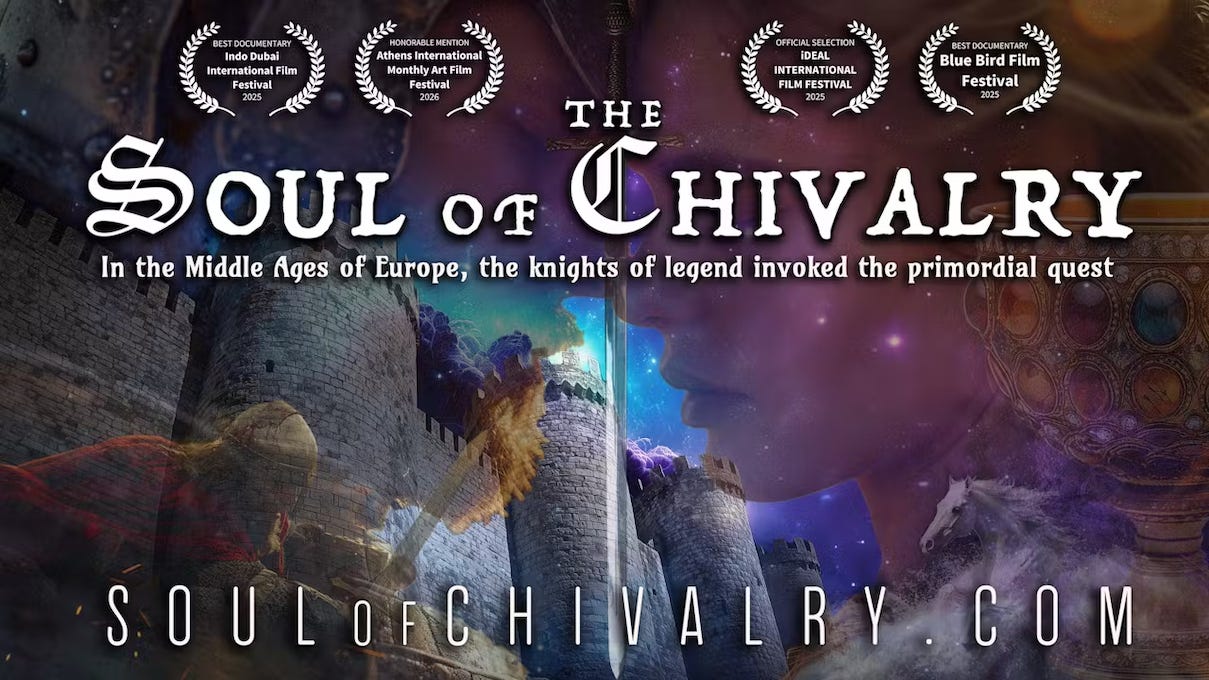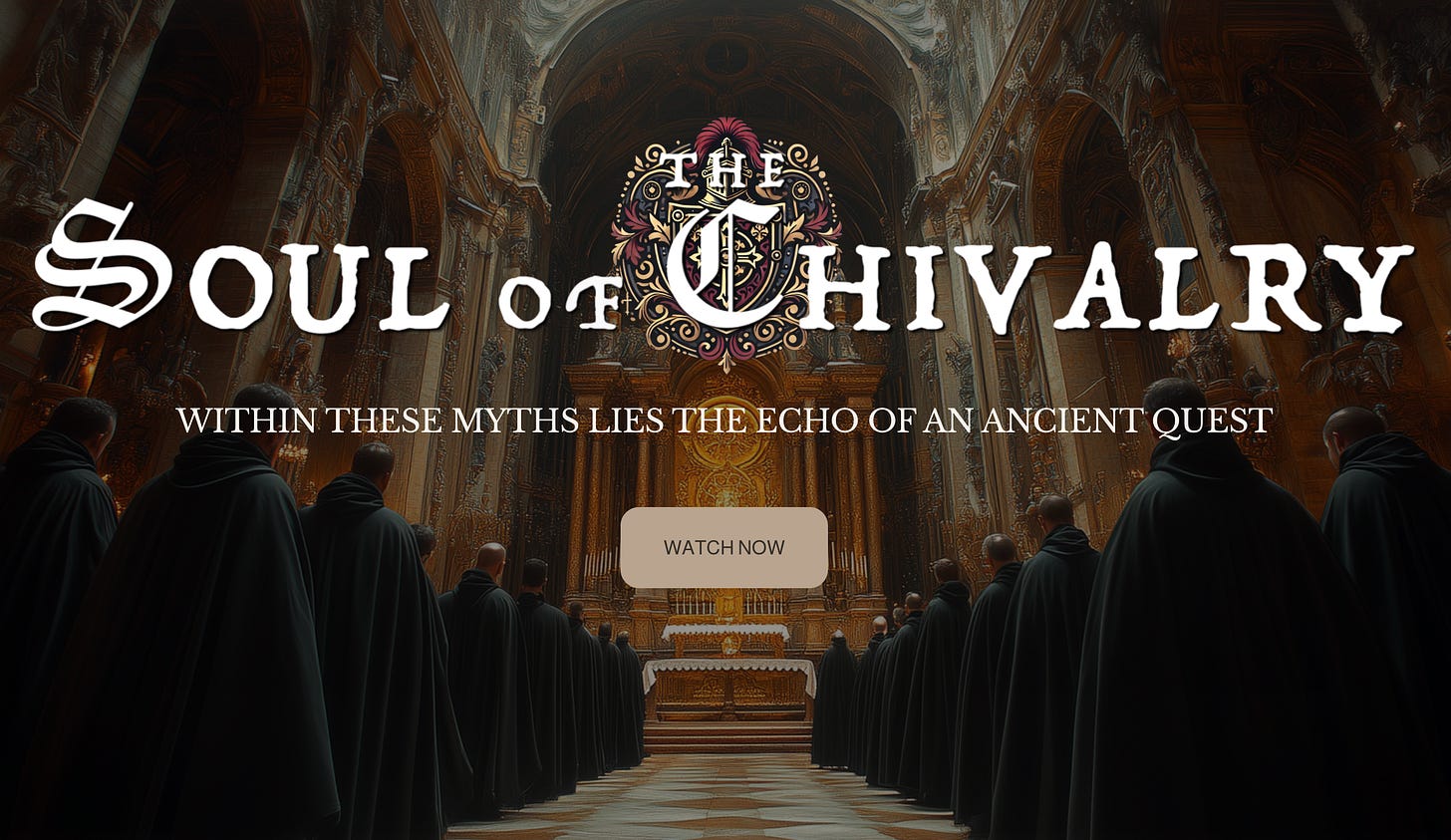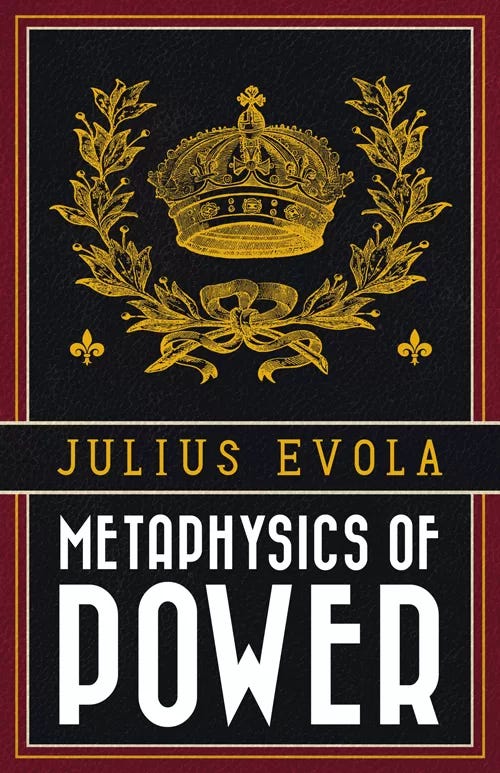Film Review: PhilosophiCat's Soul of Chivalry
by James Traven
A review of The Soul of Chivalry (2025) by Cat Weiss (“PhilosophiCat”). Watch it here.
James Traven reviews PhilosophiCat’s ‘The Soul of Chivalry’ as a visually striking, mythopoetic documentary that distills Julius Evola’s teachings on chivalry, initiation, and transcendence, invoking the lost spiritual ideals of knighthood and urging viewers towards inner transformation amid the decadence of the modern age.
The Soul of Chivalry fits a great many arcane subjects into an accessible and digestible package, condensing components of Julius Evola’s ouevre concerning the chivalric tradition, the Grail legends, and the reestablishment of the eternal Solar Regnum into an original — but traditional and archetypal — narrative.
Produced by a woman who goes by the online moniker “PhilosophiCat” — an influencer with a not inconsiderable audience who describes herself in her Twitter/X bio as a “Traditionalist filmmaker” and an “Evolian acolyte” — this mythopoetic documentary seeks to set down a general line of force in which not only the concept and historical traditions of chivalry, but the very essence or “soul” thereof becomes palpable for the viewer.
The film begins with a narration of a woman and/or goddess dressed in white, who seeks to take the speaker by the hand and guide him through some otherwise unnavigable darkness. But she is pierced in the heart with an arrow, split in twain. When she falls to the ground, one half of her is shattered, while the other half is destined to become a keepsake - some memory or beloved impression - which will serve as an impetus to some act. Maybe the act will be one of vengeance, or maybe it will glorify the memory of this White Woman’s sacrifice. Most of all, it will goad the young, gallant Man toward an act of transformation and transcendence.
Immediately, as one watches this opening visual sequence while listening to the voice-over, a kind of uncanniness settles in. The woman being portrayed on the screen would appear to be an actual human actress, though the forest in which she floats and twists straddles an uncertain boundary between computer-generated simulacrum and some reified, hyper-real sylvan panorama, sharpened and augmented by the 4K resolution in which it may or may not have been captured. We come to a close-up of this woman’s nearly affectless face as she stares into some unseen sky, both dead and incorruptible.
After this prefatory monologue, we are shown a quote from Miguel Serrano’s Nos: Book of the Resurrection:
“The woman dies. She is dead. She must die in order to return to life. She is the warrior’s companion, existing only in his mind, in his spirit. Only with the memory of his beloved in his head can the initiate achieve the Grail.”
Thus, we proceed into a meditative narrative in which the dulcet female narrator guides us through a series of topoi which reflect the institution of medieval European chivalry, its ancient roots, and its future prognosis.
We begin by learning about the basis of the chivalric code. The knightly ethic is one motivated neither by any temporal decree, nor by any papal dictat. Rather, the heroic path is one trodden only with deference toward that which the narrator, via Evola, refers to as the “Law from Above” – the eternal, vertical principle of self-purification, self-transcendence, and self-transmutation. The chivalric code rests on the pillars of Honor, Prowess, Loyalty, and Piety. Knights embody these virtues through an attitude of Amor Fati (a “love of fate” which causes the warrior to embrace his embattled position in the world, and the sacrifice that comes with dying a heroic death).
In addition, the knight must adhere to the principle of Fides, or fidelity – faithfulness and devotion to one’s land and lord which, in turn, serve as manifestations of certain metaphysical archetypes. In the chivalric tradition, the knight swears his immediate fealty to the martial priesthood which he is entering. By contrast, the knight must eschew any trace of falsehood or dishonor; lying is a grave stain on the soul and visage, something cowardly, the purview of the hopelessly profane.

The code of chivalry is the foundation of the journey of initiation that unfolds over the course of the film. As we make our way further, we are presented with an intricate exposition of the Hermetic and esoteric symbols and mythical codices which underly the edifice of the knightly office. The training of the knight from childhood occurs in adherence to the number 7: at 7 years of age, a child may become first a page, learning the basic laws, ethics, and spirit of knighthood; at the age of 14, the page may become a squire, begin his instruction in the art of war and combat, and potentially even lay down his life in actual battle; finally, at the age of 21, the knight has reached that perfected, trebled age of sevens at which he may enter knighthood as such.
At the same time, the film portrays becoming a knight as a sort of ad hoc initiation that can be magically transmitted. One knight practically breathes his soul of chivalry into the neophyte, as though it were some magnetic fluid conferred bodily. Much is made at this point in the narrative of the Hermetic symbolism of the knight’s vestments during and after initiation, namely their color scheme of black, white, and red, which indicate respectively the various stages in the alchemical magnum opus, the dissolution of the “work in black” (Nigredo), the crystallization of the “work in white” (Albedo), and the perfection and attainment of the “work in red” (Rubedo) — the creation of the philosopher’s stone.
We are shown the mythical predecessors of the chivalric tradition, and how the figure of the horse features in them so prominently. This horse must be mastered and saddled by the knight, and if he should ever be dismounted, he would inevitably lose his knighthood, as the horse symbolizes the primal passions which he must overcome. The white horse, especially, figures as the herald of the overthrowing of the Dark Age – the Kali-Yuga – as the victorious Kalki-avatara rushes forth to trample the priests of pestilential inversion. As I watched through this segment of the film, Evola’s famous dictum to “ride the tiger” slowly began to morph for me into the phrase, “ride the white mare into the nightmare.”
The last third or so portion of the film is concerned with the image and role of the Woman who represented the occasion for the film’s commencement. The woman is the erotic stimulus for the knight, an ever-present temptation to which he must continuously expose himself while not relenting to his appetites. PhilosophiCat is due credit for having craftily illustrated the Tantric paradox of the Lunar, Feminine essence, and effectively distinguishes the exalted role of the Woman in Evola’s concept of the Solar Eternal Kingdom from the morbid and perverted gynocentric structures which turn a man into a woman through his desire therefor.
After an intriguing and immersive mystery had played itself out across my laptop screen, I was treated to a great surprise: the documentary concludes with a bardic music video, featuring PhilosophiCat herself as vocalist and subject. She, together with a male figure who wears a Hermetic pendant about his neck, sings about the “flower” of the invisible and eternal Regnum, all the while traipsing wistfully through a wood. The Masculine and Feminine stand-ins harmonize over montage imagery of bedchamber trysts and solar worship on the grounds of ruined castles. When the music cascades into silence, the screen fades to black, and the following quote makes its silent appearance in an abyssal field:
“We are men of the Middle Ages, not only because that is our destiny, the fatality of history, but also because we will it. You, you are still men of modern times, because you refuse to choose.”
- Nikolai Berdyaev
Ultimately, this film is a laudable digest of certain aspects of Evola’s conceptual universe. But more than a digest, it is an invocation of the very spirit of chivalry. It is, therefore, part documentary and part “fantasy,” or part canon and part imagination.
One of the most curious aspects of the documentary, then, is its no doubt deliberate and calculated employment of AI images; on the surface, such a Kali-Yugic, mechanistic tool might seem counter-intuitive, if not downright subversive to PhilosophiCat’s message. But there would appear to be a latent subtext here that enriches the overall incitement (if not subtly a provocation) of the piece. Visually, the documentary is comprised of a patchwork of real-world drone footage showing symbolically evocative historical sites, creeping pseudo-stills of uncanny AI-generated figures and tableaux, and pointedly grotesque and mechanical 3D objects. At one moment, the viewer’s perspective is made to soar above a crenelated castle on a lone promontory in the Germanic heartland, or peer through the frame of a Japanese Shinto Torii as the sun expires behind it, casting doomed copper rays onto the gate’s pedestal of volcanic rock while it is covered over by simmering sea foam; at another moment, a legion of computer-generated knights clad in armor march toward the virtual camera in perfect synchronization, their low polygon count only heightening the feeling that something both incredibly vulgar and profound is being embodied for the intended audience.
The message may be that, even though the door to that invisible realm where the sacrament of the Graal lies dormant has been shut to us in our miserably vulgar time, we cannot retreat from the horrors and chimerae of this black age. Rather, we must press forth into the perilous swamps of the info-sphere, bombarded as we are with the worthless residue of some universal process of putrefaction and dissolution. When the time comes, Kalki will appear on the horizon in his blinding white raiment, his steed stamping the ground until it collapses.
Overall, from the discursive, to the aesthetic, to the meta-narrative, The Soul of Chivalry is a film worth watching — and pondering. It throws down a gauntlet before the weary internetic traveler, speaking to him in a dialect that is both hauntingly familiar and mortifyingly foreign.
To imbibe the Soul of Chivalry, we must drink the bitter waters of our own spiritual squalor. We can no longer roll out a crimson carpet of blood spit from the tips of our swords as we tread the Hero’s Path in the way that the knights of a bygone time once did, but God will one day elect a new initiate to seek that eternal Chalice, and to take his rightful place on the Siege Perilous. This film reminds us of this path, expounds some of its principles, and shows he exhilarating worlds that open up to the spirit that sets out on the Quest.
READ MORE by Julius Evola: The Metaphysics of Power, brought to you by Arktos:





